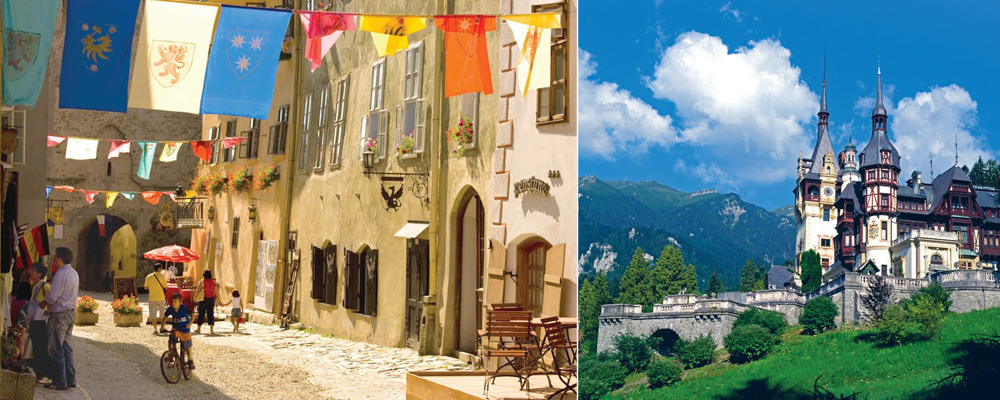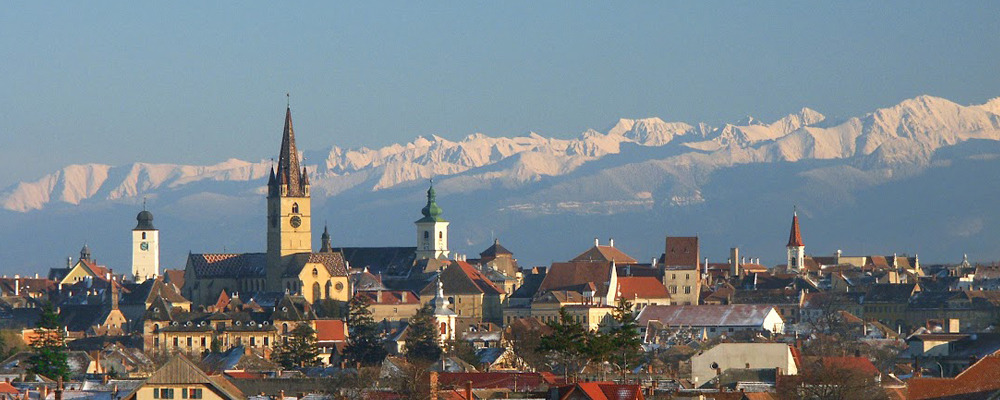Romania: Transylvania and the Tales of Dracula
Emily Manthei
The farthest outpost of the opulent Austro-Hungarian Empire is beautiful, lush, exotic and mysterious. Central Romania is also known as Transylvania and the home of Bram Stoker’s “Dracula,” who was loosely inspired by the 15-century prince Vlad Dracul. As Vlad protected Romanians from an enemy invasion, he was known for brutal beheadings, which earned him the posthumous moniker Vlad the Impaler.
Transylvania is still revered (or reviled) for the castles and towns associated with Vlad’s terror — and the region’s tranquil air can sometimes inspire shivers that even Jonathan Harker couldn’t ignore — but today’s friendly, round-faced Transylvanians are centuries-removed from Vlad’s infamous ghoulish figure. Case in point: the cosmopolitan Transylvanian capital Cluj-Napoca is filled with sophisticated university students as well as bookstores, museums, gourmet coffee shops and quaint movie theaters along ancient cobblestone streets.
Travel across the Transfagarasan Highway as it zigzags through a valley and up the Fagaras Mountains for one of the world’s most stunning and scenic drives. Pack a picnic and hike into the inviting forest, where you’ll never truly be alone amid the whispering trees. You can take a carriage ride to re-create Mina Murray’s trip along this increasingly desolate route — but don’t forget to pack some garlic, just in case.
Explore the vampire’s lair at Bran Castle, which towers above the village of Brasov. It’s the only castle in Transylvania to fit Bram Stoker’s description of Dracula’s castle: “…on the very edge of a terrific precipice … with occasionally a deep rift where there is a chasm [with] silver threads where the rivers wind in deep gorges through the forests.” The castle’s history traces back to 1211, when it was erected as a fortress protecting the region from invaders outside the Empire. Vlad passed through Brasov in an attempt to keep German invaders away from Wallachia, and was possibly imprisoned in the castle by Hungarian rulers before being transferred to Corvin Castle, where he would spend his final days eating rats in a tiny dungeon (this is definitely where you’ll want to don your cape and fangs on Halloween night). Stoker also incorporated regional beliefs of Transylvanian villagers into his “Dracula” mythology. According to legend, people in the surrounding villages led normal lives by day and became disembodied souls at night, tormenting and killing people in their sleep until dawn, when the power of these undead souls would fade.
Visitors can watch international interpretations of the vampire legend at the Dracula Film: Fantasy and Horror Festival in Brasov on October 18–22. The five-day fest features a slate of spooky shorts and features with vampire films based on “Dracula” having their own category (fantasy films and short form compete separately). The small festival creates a place for Romanian filmmakers to shine, but entrants from all over Europe are represented.
Visit Vlad Dracul’s birthplace in the town of Sighişoara, a UNESCO World Heritage site. The brightly colored central houses and fortified walls are some of the last relics of the Transylvanian Saxon culture that was so rich in Europe for centuries. The brooding atmosphere recalls old Prague or Vienna, with architecture that crosses the Gothic and Latin influences of the Roman Empire with the Orthodox and Byzantine influences of the Austro-Hungarian Empire.
The well-heeled cultural capital of Cluj-Napoca is a city built by the Romans in the 2nd century on the ruins of the 2,000-year-old settlement Napoca. Visit the Lucian Blaga National Theatre, the 100-year-old cultural monument built by Viennese architects. On October 10, the playhouse premieres the new show “Clownzilla: Illegal Aliens” by Eli Simon, a whimsical story of child-like alien creatures forced to adapt to life on Earth. Also be sure to take in the Hungarian Opera.
While there’s plenty to see and do in Transylvania, remember than Romania is still a developing country in Eastern Europe. Most quaint small towns won’t offer high-end nighttime entertainment and dining or luxury accommodations, as this is called the “Old World” for a reason. If you’re interested in a more cosmopolitan flavor, skip straight to Cluj-Napoca.
Sighişoara and Sibiu:
If you’re hungry, grab a wooden cross and enjoy your last meal in Vlad’s home town of Sighişoara. Restaurant Casa Vlad Dracul serves classic Transylvanian dishes, from meats with fragrant sauce, cabbage or potato-based sides to French patisserie-perfect desserts. In the nearby town of Sibiu, Crama Sibiul Vechi serves craving-inducing soups and mutton in a brick cellar that is anything but coffin-like (no, really). And stick around for live music in the evenings.
Bed and Breakfast Kula (+40 265 777 907; Str Tamplarilor 40, Sighişoara; less than $30 a night) provides a modest but atmospheric choice inside a 400-year-old house crammed with antique furniture. The intimate setting offers homemade wine and English-speaking hosts to make for a quaint and pleasant stay. The updated 1683 Hotel Claudiu (around $40 a night) in Sighişoara’s central Citadel offers 16 surprisingly modern rooms with large windows in the vaulted ceilings. And nearby Casa Wagner ($50 a night) is a hotel with the superior wine cellar that stays true to its Gothic roots.
In and Around Braşov:
Meaty continental fare features heavily at Sergiana, a clean, curvaceous dining hall in Braşov’s central district. For a more atmospheric and moody dinner destination, descend into the castle-cave basement of Bella Muzica a restaurant inside a beautiful Neoclassical hotel ($80 a night), with immaculate modern updates and romantic 19th-century furniture. After a few shots of the local plum alcohol, you’ll be glad that you’re already checked in upstairs.
A short drive out of Brasov, spend the night in one of the guesthouses owned by Charles the Prince of Wales in Miklósvár or Valea Zălanului. Both are stunningly restored 19th-century farmhouses surrounded by gardens that provide much of the produce for dining. The rare “black Transylvanian bare-necked chickens” are raised on site and bred for eggs and meat. Breakfast and dinner are served in the dining room, while lunch can be taken on a countryside picnic. The candlelit wine cellar at the Miklósvár guesthouse sets the scene for a 19th-century murder mystery, so prepare your alibi. Single-night rates start at $60 and are discounted for longer stays.
Cluj-Napoca:
Local Romanian food shines bright with a modern edge in Cluj-Napoca, with creative chefs updating the heavy, meaty classics. Restaurant Matei Corvin delivers traditional Continental brunch, authentic Transylvanian fare and a creative vegetarian menu. With inside and cobblestone seating, you’ll find the perfect spot to relax over a bowl of Hungarian goulash or cheese-and-fruit plate. Regional Transylvanian cuisine that incorporates Hungarian, Italian and Armenian influences is the specialty of Casa Ardeleana, where your dinner comes with Romania’s signature drink of plum wine. Finally Bistro Vienna plays up the vintage excitement of fin de siecle Vienna and specializes in Austrian ribs, sausages and schnitzel.
With cultural, linguistic and culinary influences of the Medieval Roman Empire, Italian-style cooking is the heart of fine dining in Cluj-Napoca. The Franco-Italian menu of Napoca 15 is simple but elegant. The desserts and wine shine brightest and can be enjoyed on the patio overlooking the city’s central square. Through the rugged blue door into the charming Camino, you’ll find one of Cluj-Napoca’s most-awarded restaurants, which serves lunch or dinner to please a gourmet palette. Save a dinner for Bricks (M)eating Place, where colorful Mediterranean-inspired dishes are set against old-world, brick-laden walls. Stick around for jazz and drinks in the lounge. Healthy, local ingredients and a New American style of elegant plating set Baracca apart, as the restaurant placed third in Romania’s 2013 “Excellence in Hospitality and Tourism” Awards.
On Halloween night, descend into a dim, grotto-like basement with brick-and-stone walls and Euro-trance music. Diesel Club makes an excellent hideout for moody vampires and costumed revelers. Above ground, the Klausenburg Cafe offers alluring Austrian palace opulence and extensive menu. The thick, European drinking chocolate will draw you in, but the wine/whiskey/dessert/cocktail menu will keep you chatting under the warm glow of the bar’s crystal chandeliers.
For a cozy stay minutes from central Cluj-Napoca, the four-star Hotel Paradis offers clean and modern rooms at comfortable prices: $70 a night gets a single room with pools, spa, sauna and massage facilities. If you think you’ve seen the Grand Hotel Italia somewhere before, you probably remember the film “The Grand Budapest Hotel.” Combining classic elegance and modern Italian design, the boutique hotelier offers cosmopolitan charm and panoramic views of “old” Cluj and “new” Cluj-Napoca for $200 a night.



